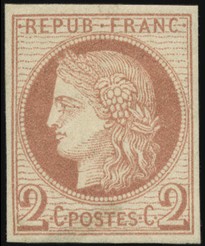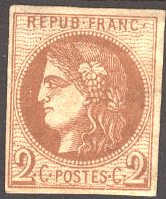 |
|||||
|
|||||
| Preview of Stamps Catalogue: VOLUME 1 |
 |
|||||
|
|||||
| Preview of Stamps Catalogue: VOLUME 1 |
Return To Catalogue - Ceres type, forgeries, part 1 - Ceres type forgeries, part 2 - Essays and proofs of the first stamps of France - 1862 reprints of the first stamps - France overview
Note: on my website many of the
pictures can not be seen! They are of course present in the catalogue;
contact me if you want to purchase it.
1849 issue:
10 c brown 15 c green 20 c black 25 c blue 40 c orange 1 F red (issued in two shades)
The 20 c and 1 F were issued 1st January 1849 and were the first stamps issued in France. The 40 c was issued 3rd February 1850, the 25 c 1st July 1850, the 15 c 29th July 1850 and finally the 10 c 12th September 1850. The 1 F stamp exists in two different shades; carmin-red and vermillion (the first issued colour, was considered too similar to the 40 c orange stamp, in order to avoid confusion it was replaced by a different shade of dark red in 1849), as well as an unissued light orange variety. In 1895, the French stamp dealer Vervelle bought a sheet of the 1 Franc light orange after it was found with the printer's papers, ever after these stamps are known as Vervelle stamps (the Vervelle stamps were never issued for postage use and have no gum).


(Left vermillion and right carmin-red, images obtained from
http://www.sandafayre.com )
The 40 c exists in 2 types: with normal '4' and with slanting '4' (rare).

Non-issued 20 c blue (don't confuse this stamp with a French
colonies 20 c blue stamp)
An unissued 20 c blue and an essay 25 c (in red) on 20 c exist (extremely rare, since almost the whole stock was destroyed).

(Reprint of an essay; 25 c on 20 c, image obtained from
http://www.sandafayre.com )
Reprints exist of all values, including the unissued 20 c blue and the essay (but with '25 c' overprint instead of '25'), generally in lighter colours than the original stamps on whiter paper. They were made in 1862. Click here for picture of these 1862 reprints.
Don't confuse the 10 c, 20 c blue and 40 c with the Bordeaux issue of 1870!
The printer included some cliches upside down when printing the plates (all values except 40 c), creating some very rare tete-beche pairs:

(A very rare 10 c tete-beche, image obtained from
http://www.sandafayre.com )
The rate for local letters weighing less than 7
1/2 g (except Paris) was 10 c. In Paris the rate for local
letters (again less than 7 1/2 g) was 15 c. The rate for letters
up to 7 1/2 grammes was 20 c (to be send anywhere in France or
Algeria). Letters weighing 7 1/2 to 15 grammes were to be franked
with 40 c and upto 100 grammes with a 1 Franc stamp. Each
additional 100 g had to be franked with another 1 F stamp. The 40
c was also used for letters to certain foreign countries. The 25
c replaced the 20 c on 1st July 1850 as the rate for one bureau
to another for letters weighing less than 7 1/2 g.
The color of the 1 F was done in two shades (apparently
deliberately by the postal authorities). The lighter shade of red
(vermillon) of the 1 F was witdrawn in December 1849 in order to
avoid confusion with the 40 c stamps. The darker shade of red
(carmin) was still sold until the stocks were exhausted (1854).
380,000 Stamps of the lighter shade of red were sold and about 2
million of the darker shade.
Value of the stamps |
|||
vc = very common c = common * = not so common ** = uncommon |
*** = very uncommon R = rare RR = very rare RRR = extremely rare |
||
| Value | Unused | Used | Remarks |
| 10 c | RR | RR | Issued 12 September 1850. About 17 million stamps were issued. Tete-beche stamps exist. |
| 15 c | RRR | RRR | Earliest used date known: 29 July 1850. 3.3 million stamps were issued. Only one tete-beche stamp exists. |
| 20 c | R | ** | Issued 1st January 1849 About 31 million stamps were sold |
| 25 c | RRR | *** | Issued 1st July 1850. 45 million stamps were issued. Tete-beche stamps exist. |
| 40 c | RRR | RR | Issued 3rd February 1850 Exists with retouched '4':RRR Tete-beche stamps do not exist for this value. 4.1 million stamps were issued. |
| 1 F | RRR | RR | Issued 1st January 1849 Other shades: RRR |
For cancels on the first issues of France click here.
For forgeries of the Ceres type click here, here or here for Sperati forgeries of all values except 1 Fr or Sperati forgeries of the 1 Fr value .
From 1852 to 1870 stamps with the face of Napoleon III were used, click here for these stamps. Due to the surrender of Napoleon III to the Germans, the 1849 design was re-introduced.
1 c olive 2 c brown 4 c grey 5 c green 10 c brown 20 c blue 30 c brown 40 c orange 80 c red
The Bordeaux issue became necessary when Paris was besieged by German troops in 1870. These stamps were printed in Bordeaux and were used in the non-occupied territories.
Other imperforated Ceres stamps exist for the French colonies. The design is slightly different (design similar to the perforated Ceres stamps, however the motifs at the left and right are different and the shading of the face is also different). Possibly the easiest way to distinguish them are the 'R' of 'REPUB.' and the 'C' of 'FRANC'; they are quite close to the left and right borders for the French Colonies issue, while they are far away from the borders in the Bordeaux issue.




Left: French colonies 2 c and 4 c stamps, right: a 2 c and 4 c
Bordeaux issue. Note the distance between the central circle and
the word "POSTES".
Value of the stamps |
|||
vc = very common c = common * = not so common ** = uncommon |
*** = very uncommon R = rare RR = very rare RRR = extremely rare |
||
| Value | Unused | Used | Remarks |
| 1 c | R | R | |
| 2 c | RR | RR | |
| 4 c | RR | RR | |
| 5 c | RR | R | |
| 10 c | RR | *** | |
| 20 c | RR | * | 3 types: Type 1: chin is formed with dots; thin
letters (RR) Type 2: chin with lines; thin letters in the inscriptions (**) Type 3: chin with lines; larger letter in the inscriptions (*). |
| 30 c | RR | R | |
| 40 c | RR | *** | |
| 80 c | RR | RR | |
Click here for Sperati forgeries of these stamps.
Large value in the lower corners (1871)
1 c olive 2 c brown 4 c grey 5 c green
Value small (1870-1875, as 1849 issue):
10 c brown ('Siege de Paris')
10 c brown on red (2 types, small and large figures of value)
15 c brown (2 types, small and large figures of value)
20 c blue ('Siege de Paris')
25 c blue
30 c brown
40 c orange ('Siege de Paris')
80 c red
These stamps have perforation 14 x 13 1/2.
Value of the stamps |
|||
vc = very common c = common * = not so common ** = uncommon |
*** = very uncommon R = rare RR = very rare RRR = extremely rare |
||
| Value | Unused | Used | Remarks |
| 1 c | * | * | |
| 2 c | ** | * | |
| 4 c | *** | ** | |
| 5 c | *** | c | |
| 10 c brown | R | *** | |
| 10 c brown on red | R | * | |
| 15 c | *** | vc | |
| 20 c | *** | c | |
| 25 c | *** | c | |
| 30 c | RR | * | |
| 40 c | RR | c | |
| 80 c | RR | * | |
The 10 c brown, 20 c blue and 40 c orange are also known as 'Paris-besieged' (Siège de Paris) issue.


Mispring: 25 c with 'smoking' Ceres; image obtained thanks to
Christophe Veysseyre
These stamps have been issued imperforated in the french colonies (general issues, not to be confused with the Bordeaux issue!).


Further issues: french colonies, general
issues
Click here for essays and proofs of the first stamps of France.

(Souvenir sheet for the PEXIP exhibition, Paris 1937)

(10 F stamp of 1949 in a mini-sheet commemorating 100 years of
Ceres issue)


Later issued with the head of Ceres
An imitation of the french Ceres stamps was issued in Corrientes (Argentine). The stamps have the head of Ceres, but are printed very poorly in general (and several forgeries exist):

Here some forgeries of these Corrientes stamps